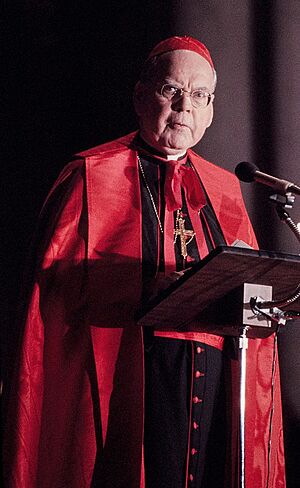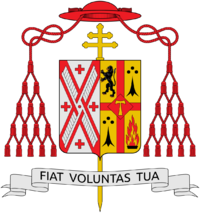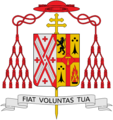Terence Cooke facts for kids
Quick facts for kids His Eminence Terence James Cooke Servant of God |
|
|---|---|
| Cardinal, Archbishop of New York | |

Cooke in 1983
|
|
| Church | Roman Catholic Church |
| See | New York |
| Appointed | March 2, 1968 |
| Enthroned | April 4, 1968 |
| Reign ended | October 6, 1983 |
| Predecessor | Francis Spellman |
| Successor | John Joseph O'Connor |
| Other posts | Cardinal-Priest of Ss. Giovanni e Paolo Vicar Apostolic for the United States Armed Forces |
| Orders | |
| Ordination | December 1, 1945 |
| Consecration | December 13, 1965 by Francis Spellman |
| Created Cardinal | April 28, 1969 |
| Rank | Cardinal-Priest |
| Personal details | |
| Born | March 1, 1921 Manhattan, New York, U.S. |
| Died | October 6, 1983 (aged 62) Manhattan, New York, U.S. |
| Buried | St. Patrick's Cathedral (New York) |
| Nationality | |
| Parents | Michael Cooke & Margaret Gannon |
| Previous post |
|
| Motto | Fiat Voluntas Tua (Thy Will Be Done) |
| Sainthood | |
| Venerated in | Roman Catholic Church |
| Title as Saint | Servant of God |
| Attributes | Cardinal's attire |
| Styles of Terence Cooke |
|
|---|---|
 |
|
| Reference style | His Eminence |
| Spoken style | Your Eminence |
| Informal style | Cardinal |
Terence James Cooke (born March 1, 1921 – died October 6, 1983) was an important leader in the Roman Catholic Church in America. He was a Cardinal and served as the Archbishop of New York from 1968 until he passed away. During his time as Archbishop, he bravely battled leukemia.
In 1969, he was named a Cardinal. Before that, he was an auxiliary bishop for the Archdiocese of New York from 1965 to 1967. Nine years after his death, Cooke was given the title of Servant of God. This is the first step in a special process that might lead to him being recognized as a saint.
Contents
About Terence Cooke
His Early Life
Terence Cooke was the youngest of three children. He was born in New York City to Michael and Margaret Cooke. His parents came from County Galway, Ireland. They named him after Terence MacSwiney, a mayor from Ireland who died during a protest.
His father, Michael Cooke, worked as a chauffeur and in construction. When Terence was five, his family moved from Morningside Heights, Manhattan, to the Bronx. After his mother died in 1930, his aunt Mary Gannon helped raise him and his siblings.
Becoming a Priest
Terence showed interest in becoming a priest early on. In 1934, he went to Cathedral College in Manhattan. This was a special school for young men who wanted to become priests. In 1940, he continued his studies at St. Joseph's Seminary in Yonkers, New York.
Archbishop Francis Spellman made Cooke a priest on December 1, 1945. Cooke then worked as a chaplain at St. Agatha's Home for Children in Nanuet, New York, until 1947. After that, he went to The Catholic University of America in Washington, D.C., to study more. He earned a degree in Social Work in 1949.
When he came back to New York, Cooke worked at St. Athanasius Parish in the Bronx. He also helped with the Catholic Youth Organization. In 1954, he became the director of the Youth Division of Catholic Charities. Cardinal Spellman then chose him to be his secretary in 1957. Cooke was given the title of monsignor that same year. He also became the vice-chancellor for the archdiocese in 1958, and then the full chancellor in 1961.
Becoming a Bishop
On September 15, 1965, Pope Paul VI appointed Cooke as an auxiliary bishop for the Archdiocese of New York. An auxiliary bishop helps the main bishop. He became a bishop on December 13, 1965, in a special ceremony led by Cardinal Spellman at St. Patrick's Cathedral.
Cooke chose a special motto for himself: Fiat Voluntas Tua. This means "Thy Will Be Done" from the Bible. He helped organize Pope Paul's visit to New York in October 1965. Just two days after becoming a bishop, he was named Vicar General of the Archdiocese. This means he was a chief assistant to the Archbishop. In that same year, 1965, he was diagnosed with acute myelomonocytic leukemia, a type of cancer.
Archbishop of New York
After Cardinal Spellman died in 1967, Pope Paul chose Cooke to be the new Archbishop of New York on March 2, 1968. This was a surprise to many people. Cooke was officially installed as Archbishop at St. Patrick's Cathedral on April 4, 1968. He also became the leader for Catholic military members in the U.S.
On the same day Cooke became Archbishop, Reverend Martin Luther King Jr. was sadly killed in Memphis, Tennessee. This led to unrest in many cities. Cooke went to Harlem that evening to ask for peace. He also attended King's funeral. Later, after Attorney General Robert F. Kennedy was killed, Cooke led his funeral at St. Patrick's Cathedral.
On January 20, 1969, Cooke gave a special prayer at the start of President Richard Nixon's term. Cooke helped bring changes from the Second Vatican Council to his archdiocese. He also used a more teamwork-focused way of leading. Pope Paul VI made him a Cardinal on April 28, 1969. At that time, Cooke was one of the youngest Cardinals.
During his time as Archbishop, Cooke started many helpful programs:
- The Birthright organization, which helps pregnant women.
- The Inner-City Scholarship Fund, which helps students pay for Catholic schools.
- A housing program to help people in need in New York.
- Catholic New York, the archdiocese's newspaper.
- Nine nursing homes for the elderly.
In 1979, Cooke welcomed both the Dalai Lama and Pope John Paul II to St. Patrick's Cathedral.
His Final Years
Cooke's leukemia was found to be very serious in 1975. For the last five years of his life, he was often getting chemotherapy treatments. In August 1983, he told the public about his illness. He said he expected to live for a few more months but would not leave his job. Days before he died, he wrote a letter saying, "The gift of life, God's special gift, is no less beautiful when it is accompanied by illness or weakness..."
Terence Cooke died from leukemia on October 6, 1983, at age 62. He is buried in a special crypt under the altar of St. Patrick's Cathedral.
His Legacy
On April 5, 1984, President Ronald Reagan gave Cooke the Presidential Medal of Freedom. This is a very high honor in the United States. In 1988, he also received an award for his work in religious education.
Buildings Named After Him
Several buildings in the Archdiocese of New York are named in his honor:
- Terence Cardinal Cooke Catholic Center (the main office for the archdiocese in Manhattan)
- Terence Cardinal Cooke–Cathedral Library (now part of the New York Public Library, Manhattan)
- Terence Cardinal Cooke Health Care Center (Manhattan)
- Cooke School and Institute (for students with special needs, Manhattan)
- Cardinal Cooke Residence (for special needs, Bronx)
- Cardinal Cooke Residence (an emergency home for mothers, Spring Valley)
- Cardinal Cooke Center (a church hall, Staten Island)
Steps Toward Sainthood
Soon after Cooke died in 1983, people began to hope he would become a saint. In 1984, a group called the Cardinal Cooke Guild was started to support this idea. In 1992, the Catholic Church officially named Cooke a Servant of God. This is the first step in the process to become a saint.
On April 14, 2010, the Guild presented Pope Benedict XVI with a document about Cardinal Cooke's life and good deeds. This document is now being studied by experts. If it is approved, Cooke will receive the title of Venerable, which is the next step toward sainthood. The process is still ongoing today.
His Beliefs
His Views on World Issues
Cooke was against communism. He also disagreed with most other bishops when he spoke about nuclear weapons in 1982. He felt that having nuclear weapons to prevent war was not ideal, but could be "tolerable" in some cases. During a protest against the Vietnam War in 1968, he held a smaller event to support the war.
Cooke did not agree with the violent actions of the Provisional Irish Republican Army. During the 1983 St. Patrick's Day Parade, he stayed inside St. Patrick's Cathedral until a leader who supported the IRA had passed by.
His Views on Helping Others
Cooke started Courage International, a group that helps Catholic people who are gay or lesbian live according to Church teachings. He also supported groups like the Cursillo Movement and the Catholic Charismatic Renewal. He helped bring the Missionaries of Charity (a religious group founded by Mother Teresa) to New York.
Images for kids
See also
 In Spanish: Terence Cooke para niños
In Spanish: Terence Cooke para niños


